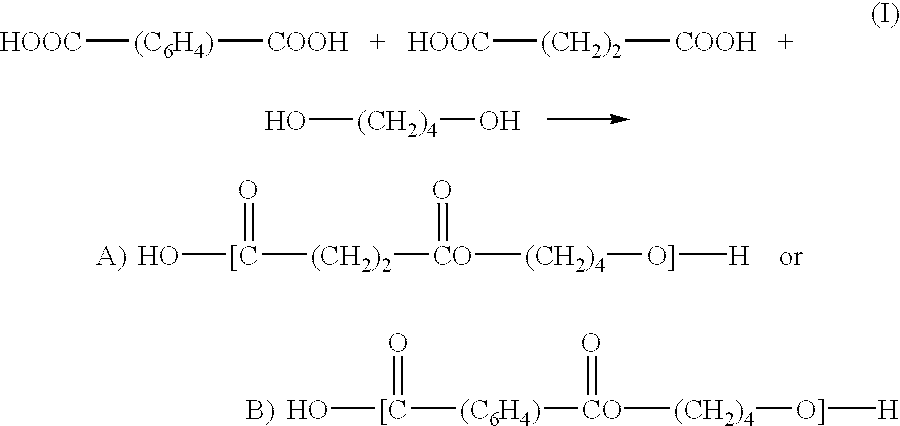Copolyester resin composition and a process of preparation thereof
a technology of copolyester and resin, which is applied in the direction of plastic/resin/waxes insulators, basic electric elements, electric devices, etc., can solve the problems of poor physical properties, high cost, and difficulty in commercialization
- Summary
- Abstract
- Description
- Claims
- Application Information
AI Technical Summary
Benefits of technology
Problems solved by technology
Method used
Image
Examples
example 1
First, after purging a 500 ml reactor with nitrogen, 19.2 g of dimethyl terephthalate and 27 g of 1,4-butanediol are added to a reactor, and the mixture is ester-exchange reacted until the approximate theoretical amount of methanol is produced at the temperature of 200.degree. C. And then, 11.8 g of succinic acid is added thereto, and the mixture is esterified until the approximate theoretical amount of water is produced at the temperature of 180.degree. C., thus obtain 39.4 g of "aromatic-aliphatic prepolymers" wherein the number average molecular weight of "aromatic-aliphatic prepolymers" is approximately 500.
And then, 118 g of succinic acid, 135 g of 1,4-butanediol and 0.3 g of tetrabutyl titanate acting as a catalyst are added thereto, and it reacts for 2 hours until the approximate theoretical amount of water is produced at the temperature of 200.degree. C. At the end of this reaction step, 0.1 g of antimony trioxide, 0.2 g of dibutyltin oxide and 0.07 g of tetrabutyl titanate ...
example 2
First, after purging a 500 ml reactor with nitrogen, 8.5 g of dimethyl terephthalate and 25 g of 1,4-butanediol are added to a reactor, and the mixture is ester-exchange reacted until the approximate theoretical amount of methanol is produced at the temperature of 200.degree. C. And then, 5.9 g of succinic acid and 7.3 g of adipic acid are added thereto, and the mixture is esterified until the approximate theoretical amount of water is produced at the temperature of 180.degree. C., thus obtain 28 g of "aromatic-aliphatic prepolymers" wherein the number average molecular weight of "aromatic-aliphatic prepolymers" is approximately 10,000.
And then, 107 g of succinic acid, 14.6 g of adipic acid, 135 g of 1,4-butanediol and 0.4 g of tetrabutyl titanate acting as a catalyst are added thereto, and it reacts for 2 hours until the approximate theoretical amount of water is produced at the temperature of 200.degree. C. At the end of this reaction step, 0.1 g of antimony trioxide, 0.2 g of dib...
example 3
First, after purging a 500 ml reactor with nitrogen, 5.91 g of terephthalic acid and 12.6 g of 1,4-butanediol are added to a reactor, and the mixture is esterified until the approximate theoretical amount of water is produced at the temperature of 200.degree. C. And then, 4.72 g of succinic acid is added thereto, and the mixture is esterified until the approximate theoretical amount of water is produced at the temperature of 180.degree. C., thus obtain 13 g of "aromatic-aliphatic prepolymers" wherein the number average molecular weight of "aromatic-aliphatic prepolymers" is approximately 400.
And then, 118 g of succinic acid, 92 g of ethylene glycol and 0.4 g of tetrabutyl titanate acting as a catalyst are added thereto, and it reacts for 2 hours until the approximate theoretical amount of water is produced at the temperature of 200.degree. C. At the end of this reaction step, 0.1 g of antimony trioxide, 0.2 g of dibutyltin oxide and 0.07 g of tetrabutyl titanate acting as catalysts ...
PUM
| Property | Measurement | Unit |
|---|---|---|
| melt index | aaaaa | aaaaa |
| temperature | aaaaa | aaaaa |
| temperature | aaaaa | aaaaa |
Abstract
Description
Claims
Application Information
 Login to View More
Login to View More - R&D
- Intellectual Property
- Life Sciences
- Materials
- Tech Scout
- Unparalleled Data Quality
- Higher Quality Content
- 60% Fewer Hallucinations
Browse by: Latest US Patents, China's latest patents, Technical Efficacy Thesaurus, Application Domain, Technology Topic, Popular Technical Reports.
© 2025 PatSnap. All rights reserved.Legal|Privacy policy|Modern Slavery Act Transparency Statement|Sitemap|About US| Contact US: help@patsnap.com


